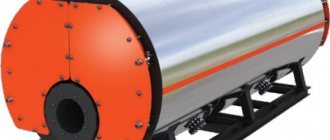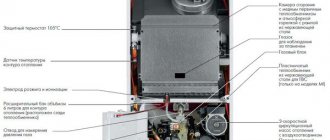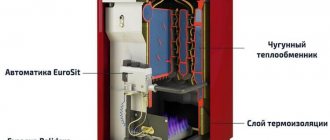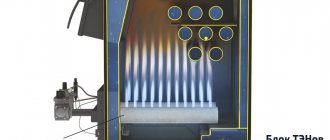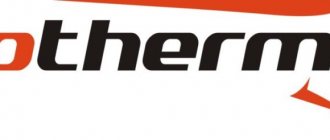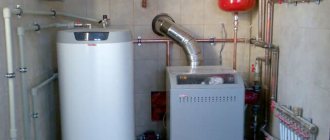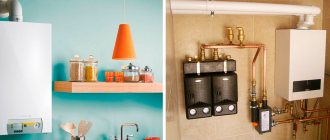Industrial boilers operating on gas fuel are in great demand today due to the high assessment of their efficiency, taking into account the rising cost of various energy sources. Such autonomous heating systems are capable of heating not only large-scale objects with large areas of interior space, but they are also suitable for heating houses with all their outbuildings (baths, garages, barns, poultry houses, etc.). It is worth studying in more detail the general characteristics of such boilers, as well as examples of several models that are considered popular on the market today.
Conditions: centralized main gas
Industrial equipment operates on centralized main gas, which is supplied from central direct gas supply systems in the city or locality. Such installations are most often used in the premises of the following facilities:
- warehouses;
- workshops;
- utility central heating points;
- administrative buildings, offices, buildings;
- indoor training grounds, playgrounds and other wide areas of premises.
Gas fuel is considered the most inexpensive than all others, which is why the equipment is more economical than solid fuel or other installations. The device has a special gas burner that directly supplies gas, and also has a special heat exchanger made of high-quality copper.
The design also includes a pump for supplying water (steam) , a pressure gauge for measuring pressure indicators, a thermometer showing the optimal heating temperature and, most importantly, a tank into which the coolant liquid – water – is supplied. To this it is worth adding a security system, which is now supplied to almost all models of modern industrial gas boilers.
Classification of gas boilers
Hot water gas boilers are installed in heat supply sources to organize the supply of hot water and heating for domestic and industrial needs.
The operating principle of such devices is the cyclic process of heating and cooling the coolant. Depending on the heating temperature, they are grouped:
- to low-temperature ones with a temperature of the heated medium up to 115 C;
- high temperature from 115 to 150 C;
- for devices that produce superheated coolant above 150 C.
According to their purpose, they are divided into two groups:
- Gas industrial over 100 kW and coolant up to 115 C.
- Household, for a private home, with power up to 100 kW and coolant up to 90 C.
Industrial gas boilers
Industrial hot water gas boilers today are the most efficient sources of heat supply. They can be made water-tube, when the coolant circulates inside the pipes and flue gases outside.
And fire-tube, when flue gases pass inside the pipes and the coolant outside. The installation of both options differs in the different design of the smoke exhaust channels.
As a rule, an industrial water heating unit consists of 2 interconnected structural parts: combustion and convection.
The first is made of steel panels, called screens based on their location: rear, side, front and ceiling. Convective heating surfaces are located after the combustion heating surfaces to ensure maximum heat removal from the flue gases.
To do this, the direction of movement of the coolant and flue gases is carried out according to the counterflow principle.
Boilers for private houses
These devices have less power and operate at a lower coolant temperature, so they can be either wall-mounted or floor-mounted.
Depending on the number of heating circuits, they are made single-circuit for heating and double-circuit for heating and domestic hot water. Single-circuit boilers may have connections for connecting an external indirect DHW heating boiler.
Heat exchangers are made of steel, cast iron and copper. The latter are mainly for wall structures. Gas fuel is burned in a furnace, which can be closed for forced movement of flue gases and open in case of natural removal of flue gases.
Hot gases wash the heat exchanger, through which the coolant for the heating circuit and domestic hot water passes. The cooled flue gases are released into the atmosphere through the flue duct.
The movement of water can occur naturally, due to the temperature difference between the hot and cold environment, and forced, using a circulation pump.
The heated coolant with a temperature of up to 90 C enters the intra-house heating network, is distributed along the risers and then through the heating radiators, where it releases thermal energy to the air in the room, cools and returns to the boiler for the next heating cycle.
Types of boilers: hot water, steam pyrolysis
Depending on whether the device will heat a hangar or a small warehouse, two heating supply options are provided - steam or hot water. To heat indoor production areas, hot water boilers are most often used. And the steam pyrolysis option is well suited for residential buildings and small premises. Which of them is more economical and which is more expensive should be calculated individually, based on the parameters of the area, principle and design of each model separately.
Heating boiler Protherm Bizon NO 100
Additionally: automatic boiler control, automatic fuel filling
The improvement of gas industrial boilers lies in the fact that they have automatic control, as well as automatic “filling” of fuel.
Automation consists of the following elements:
- Control block;
- elements that control the operation of the boiler - sensors, valves, control with a built-in microprocessor;
- elements safety system - warn of leaks, pressure drops, temperature increases, etc.
Thanks to this system, it is possible to control the supply of energy, shutdown, ignition of the flame, stability, and uniformity of pressure distribution in the system. And other. This also achieves significant savings in gas consumption.
Advantages and disadvantages
The advantage of using industrial gas boilers in areas such as agriculture, production, administrative or residential buildings is easy installation and long-term operation without major repairs. But there are other advantages, which are as follows:
- The heat transfer coefficient is high , more than the consumption coefficient.
- The coolant in such boilers does not need to be brought to a boil, which eliminates the risk of compromising the integrity of the heating system itself.
- Work on different types of liquid energy without significant losses.
- Fluid movement is straight forward.
- Climate change regulators control the operation of the system.
- A control and measuring set of instruments is included in the boiler package.
- Perfectly mounted in a block-modular boiler system .
- There is protection against scale.
- Compact dimensions.
- Availability on the market.
- There is no need to connect to a power supply, which significantly reduces the cost of using the equipment.
The disadvantages of gas industrial installations are the following indicators:
- They consume fuel quickly and intensively.
- The price on the market is too high. You have to look for cheaper options from a direct supplier.
- Accidental extinguishing of the burner can lead to accidents and gas explosions. You need to choose a model with a built-in self-diagnosis and safety system - for example, thermostats that regulate the intensity of the flame.
SELECT A BOILER BY AREA
Steam boilers are installed where there is a need for steam. These are various branches of the food, woodworking, light, tobacco industries, medicine, agriculture, production of building materials, and fuel oil. The boiler house offers to buy steam industrial gas boilers of the series.
Industrial steam boilers with steam temperatures up to 115 °C:
- Steam boiler with a capacity of 300 kg of steam per hour;
- Steam boiler with a capacity of 500 kg of steam per hour;
- Steam boiler with a capacity of 700 kg of steam per hour;
- Steam boiler with a capacity of 1000 kg of steam per hour.
Industrial steam gas boilers with steam temperatures up to 170 °C:
- Gas steam generator 300 kg steam per hour;
- Gas steam generator 500 kg steam per hour;
- Gas steam generator 700 kg steam per hour;
- Gas steam generator 1000 kg steam per hour.
An integral part of any type of gas boiler is the gas burner. Depending on the method by which gas fuel is supplied, burners are divided into injection, inflatable and diffuse.
Injector or atmospheric burners suck in air along with a gas stream. Inflatable gas burners receive air for the combustion reaction using a fan. A mixed mixture of air and gas enters the furnace. In diffuse burners, air flows through diffusion directly to the combustion site. The boiler house equips its gas boilers with burners from both domestic and foreign companies: GBL, WEISTHAUPT, Oilon, UNIGAS and others.
The operation of industrial gas boilers is fully automated and controlled by instrumentation included in the package. This makes it possible to save on the number of service personnel.
Industrial gas boilers are extremely safe to use. An explosion valve is installed at the rear of the boiler body, protecting against high pressure inside the boiler.
The gas burner is located in the front part of the boiler on hinges, which allows it to serve as a door for inspection and repair of the boiler.
TOP – Description with characteristics and prices of three boilers (for an area of 1000 sq.m.)
We will describe the capabilities and main parameters of some industrial-grade gas boilers.
Floor-standing boiler Buderus Logano (2 boilers come in pairs)
- Heat exchanger – cast iron.
- The combustion chamber is closed.
- Power modes – 4 options.
- Control – intelligent, automatic.
- Burner type – atmospheric.
- Ignition - electric.
- Thermal power – 159-296 kW.
- Pressure – 4 Bar.
- Efficiency – 93%.
- Pressure thrust – 3 Pa.
- The chimney diameter is 250-360 mm.
- Manufacturer – Russia.
- Dimensions (LxWxH) – 1264x1420x1610 mm.
- Warranty – 2 years.
- Price – 776,550 – 950,000 rubles.
Gas industrial boiler VAILLANT atmoCraft
- Type of equipment – sectional.
- Installation - on the floor.
- Heat exchanger – cast iron.
- The combustion chamber is open.
- Control – LCD display, intelligent, automatic.
- Burner type – atmospheric.
- Ignition - electric.
- Thermal power – 157 kW.
- Pressure – 4 Bar.
- Heat transfer – 95%.
- Pressure thrust – 3 Pa.
- The chimney diameter is 250-375 mm.
- Dimensions (LxWxH) – 1145x1730x1012 mm.
- Manufacturer – Germany.
- Warranty – 2 years.
- Price – 550,000 – 750,000 rubles.
Industrial gas boiler PROTHERM NO-3500 Bison
- Heat exchanger and housing – steel.
- The combustion chamber is open.
- Association – cascade.
- Power modes.
- Control – intelligent, microprocessor-based.
- Burner type – atmospheric.
- Burners - there may be several variations.
- Different variations of energy carriers.
- Ignition - electric.
- Thermal power – 3500 kW.
- Thermal load – from 10 W.
- Heat transfer – 93-100%.
- Pressure thrust – 3 Pa.
- The chimney diameter is 250-360 mm.
- Dimensions (LxHxW) – 2146x390x1870 mm.
- Manufacturer – Russia.
- Warranty – 3 years.
- Price – 1.9-2.2 million rubles.
In conclusion, I would like to note that the selection of the optimal boiler model should be carried out with accurate calculations, and not approximate ones. Only in this case is its high level of functionality possible. A special formula is used for calculations: 1 kW (heating) per 10 sq. m. premises with excellent thermal insulation and a ceiling height of no more than 3 m. The boiler may have 1-2 circuits. You should also pay attention to the dimensions, weight and equipment of the equipment with all the necessary measuring instruments.
Popular models of gas industrial boilers
The larger the heating area, the more difficult it is to choose a heating boiler. Among all the models, the following can be distinguished:
- Wolf GKS Eurotwin gas boilers have a high efficiency of more than 95%. The equipment consists of two cylindrical chambers that are installed next to each other. Due to the large combustion chamber, the fuel is burned almost completely. In the forward and return lines, the maximum difference in temperature of the coolant can be 50 degrees. Heat loss is minimal thanks to 10 cm thick thermal insulation. Power can be from 0.45 to 1.25 mW.
- Wolf GKS Euromax gas boilers have high protection against condensation due to the heating surfaces, which are located one above the other. Equipment power 1.6-2 mW.
Among all the advantages of gas industrial plants, one can highlight the constant supply of fuel. In this way, the problem of storage and transportation throughout the enterprise, as well as loading fuel into equipment, can be avoided.
